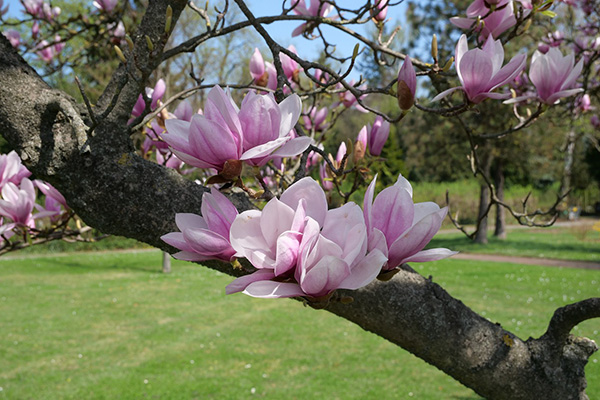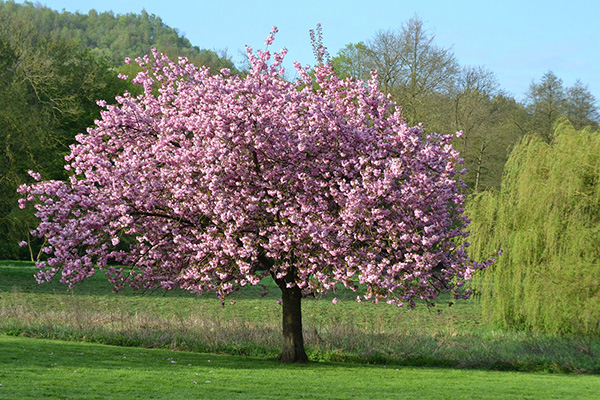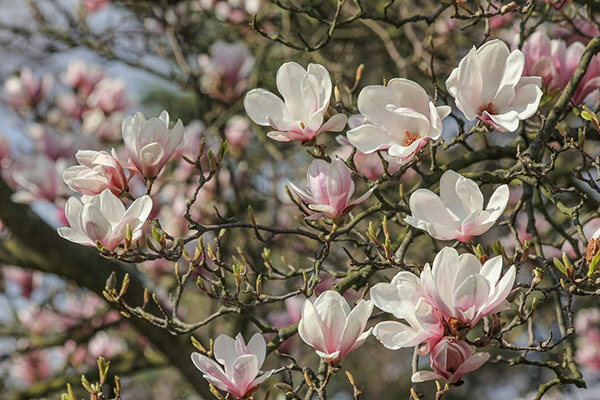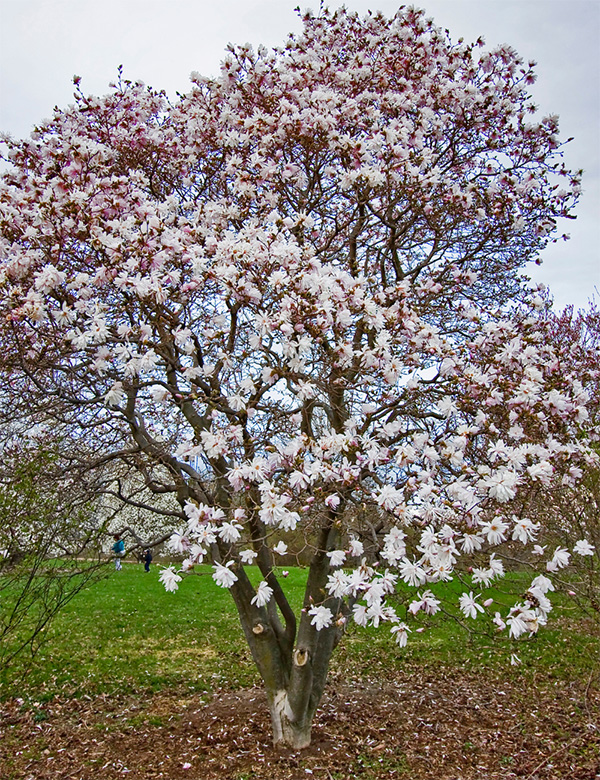Adding a magnolia tree to your garden transforms the landscape with its spectacular blooms and elegant foliage. Choose a species well-suited to your region's climate and soil conditions to promote successful growth. Optimal planting times are early spring or fall, and it is advisable to select a site with full sun to partial shade and well-draining, slightly acidic soil. Ensuring regular watering during the initial growth phase is essential for developing a robust root system. Once established, magnolias require minimal upkeep, with occasional pruning to maintain shape and health. These low-maintenance, resilient trees enhance the garden's beauty and attract pollinators, supporting local biodiversity.
One of the most striking features of the evergreen magnolias is its blossoms, which vary in color from pristine white to vibrant pinks and purples, offering a stunning visual display. These flowers not only elevate the visual charm of landscapes but also draw in pollinators, thereby making a valuable contribution to the ecosystem's biodiversity.
With their majestic presence and captivating flowers, magnolia trees are a popular choice for both public spaces and private gardens, symbolizing nobility and perseverance across various cultures. The following post will provide comprehensive information on cultivating and nurturing magnolia trees, covering all aspects you need to know for successful growth. From planting magnolias to which magnolia species to select, we will share all the tips and tricks you need to know.
Botanical Name
Common Name
Plant Type
Mature Size
Sun Requirement
Soil Type
Hardiness Zone
Pet Friendly
Magnolia spp.
Magnolia
Tree/Shrub
Varies widely, 15 to 80 feet tall, depending on species
Full sun to partial shade
Moist, well-drained, acidic to neutral pH
4-12 USDA, depending on species
Yes
What Is A Magnolia Tree
The magnolia tree, a genus comprising over 200 species, is renowned for its large, fragrant flowers and lush, evergreen or deciduous foliage. Originating from Southeast Asia and the Americas, these trees occupy diverse environments. Magnolia flowers, renowned for their captivating beauty, exhibit a range of colors, spanning from pristine white to shades of pink and purple. The tree's hardy nature allows it to adapt to various climates, flourishing primarily in USDA zones 4 through 12. Often used as ornamental plants, Magnolias hold significant cultural symbolism, representing endurance and nobility. Their unique seed pods and glossy leaves further contribute to their distinct appearance and appeal in landscapes.

Magnolia Trees Varieties
Southern Magnolia (Magnolia grandiflora): Known for its large, glossy, evergreen leaves and fragrant, white flowers, the Southern Magnolia can grow up to 60-80 feet tall. It thrives in the warm climates of USDA zones 7-9 and is native to the southeastern United States. This tree is favored due to its majestic presence and evergreen foliage that persists throughout the year.
Star Magnolia (Magnolia stellata): A smaller variety, the Star Magnolia features star-shaped, white flowers that bloom early in the spring. It typically grows 15-20 feet tall and is well-suited for colder regions, thriving in USDA zones 4-8. The tree has a bushy, rounded form and is ideal for smaller gardens.
Saucer Magnolia (Magnolia x soulangeana): This particular variety is recognized for its expansive, saucer-shaped flowers that showcase a spectrum of colors, ranging from white to pink and purple. It grows 20-30 feet tall and best suits USDA zones 4-9. The Saucer Magnolia is one of the most popular magnolias in temperate climates and is widely admired for its striking spring blooms.
Sweetbay Magnolia (Magnolia virginiana): The Sweetbay Magnolia is characterized by its creamy white, fragrant flowers and glossy green leaves, distinguished by a silver underside. It typically reaches 10-20 feet in height and is suitable for USDA zones 5-9. This variety is adaptable to wet conditions and is often found in swampy areas in the southeastern United States.
Bigleaf Magnolia (Magnolia macrophylla): As its name suggests, this variety has the largest leaves of any magnolia, reaching up to 3 feet in length. It produces large, fragrant white flowers and grows 30-40 feet tall. The Bigleaf Magnolia is best suited for USDA zones 5-8 and is native to the southeastern United States.
Kobus Magnolia (Magnolia kobus): The Kobus Magnolia is a slow-growing tree that can reach up to 25 feet tall. It has white, fragrant flowers and is suitable for colder climates, thriving in USDA zones 5-8. This variety is known for its upright, rounded form and is native to Japan.
Teddy Bear Magnolia (Magnolia grandiflora 'Southern Charm'): A compact variety of the Southern Magnolia, the Teddy Bear Magnolia features smaller, dense foliage and large, white flowers. Reaching a height of up to 20 feet, the Sweetbay Magnolia is well-suited for USDA zones 7-9. Particularly fitting for smaller spaces, this variety offers year-round appeal with its evergreen leaves.
Cucumber Tree (Magnolia acuminata): Cucumber is one of the majestic deciduous trees native to the eastern United States. Renowned for its unique, cucumber-shaped fruit and greenish-yellow, tulip-like flowers in late spring, it can reach heights of 60-80 feet. Best grown in moist, well-drained soils, it flourishes in full sun to partial shade and is ideally suited for USDA hardiness zones 4-8, making it a versatile choice for various temperate climates.

Magnolia Trees Care Requirements
Light
Preferring full sun to partial shade, magnolias benefit most from receiving at least four to six hours of direct sunlight daily. This level of exposure is pivotal for fostering the growth of resilient flowers and lush, dense foliage. While magnolias can tolerate partial shade, especially in hotter climates, optimal sunlight ensures the best flowering and overall health.
Water
The water requirements of magnolia trees are an integral aspect of their care and growth. These trees prefer a consistent moisture level, particularly during their establishment phase in the garden. To maintain optimal soil moisture without waterlogging, it is advised to water magnolias deeply once a week. Root problems may arise from overwatering or inadequate drainage. As magnolias mature, their tolerance to drought increases, reducing the need for frequent watering. Nevertheless, additional watering may be needed to supplement moisture in prolonged dry periods.
Temperature
Magnolia trees, known for their resilience and adaptability, have distinct temperature requirements that vary across species. Generally, they thrive in USDA hardiness zones 4 through 12, tolerating a wide range of temperatures.
Some magnolias, such as the Southern magnolia, prefer warmer climates and can withstand higher temperatures, while others, like the star magnolia, are more suited to cooler regions. Choosing a magnolia species that is well-suited to the local climate conditions is essential. Properly chosen magnolias can endure winter cold and summer heat, making them versatile additions to landscapes in diverse geographical locations, where they flourish and contribute to the natural beauty.
Humidity
The magnolia tree has specific humidity requirements for optimal growth. Originating from regions with moderate to high humidity, magnolias thrive in environments where the air is somewhat moist. This level of humidity helps in maintaining the tree's lush foliage and aids in the development of its vibrant blooms. While magnolias can adapt to various humidity conditions, they perform best in areas that mimic their natural habitat. In drier climates, ensuring adequate soil moisture to compensate for low atmospheric humidity is beneficial. However, the magnolia's ability to withstand different humidity levels underscores its versatility and resilience as a choice for gardeners in various geographic locations.
Soil
The thriving of the magnolia tree is contingent upon specific soil conditions. Ideal soil for magnolias is rich, well-draining, and slightly acidic to neutral in pH. These trees prefer a soil composition that retains moisture without becoming waterlogged, as poor drainage can lead to root rot. Improving the soil with organic matter can elevate its quality and nutrient composition, fostering robust growth. While magnolias can adapt to various soil types, maintaining the proper balance of moisture and aeration is crucial for their well-being. Proper soil preparation and ongoing maintenance ensure that magnolias develop robust root systems, vibrant blooms, and lush foliage, making them a stunning addition to any landscape.
Fertilization
Magnolias generally thrive when provided with a balanced, slow-release fertilizer applied during early spring as new growth initiates. This provides essential nutrients, promoting vibrant blooms and lush foliage. It is crucial to steer clear of over-fertilization, as it may result in an abundance of leaf growth, potentially overshadowing flower development. Utilizing a fertilizer specifically designed for acid-loving plants can be advantageous, particularly if the soil pH is higher than the optimal range for magnolias. Applying organic mulch around the tree base also enriches the soil naturally. Regular but moderate fertilization supports the magnolia's development, ensuring it remains a captivating feature in gardens and landscapes.
Propagation
Seed Propagation
After stratifying the seeds, plant them in a well-draining soil mix, covering them lightly. Maintain soil moisture consistently, avoiding waterlogging. Place the seed containers in a warm, bright location, avoiding direct sunlight. The germination process can span several weeks to a few months. After the seedlings emerge and reach a height of a few inches, they can be transplanted into individual pots or a nursery bed.
Cuttings
Make certain that each cutting possesses a minimum of two to three sets of leaves. Eliminate the lower leaves and insert the cutting into a rooting medium. Cover the pot with a plastic bag or place it in a greenhouse to maintain high humidity. Rooting can take several months. Once roots are well-established and new growth becomes evident, the cutting can be gradually introduced to outdoor conditions before the final transplanting.
Layering
Secure the buried section of the branch with a stake or stone to keep it in contact with the soil. The rooting process can take a year or more. During this period, ensure the soil remains moist, and the branch is not disturbed. Once sufficient roots have developed, cut the new plant from the parent tree and carefully transplant it to its permanent location.
Grafting
Select a healthy scion from a desired magnolia variety and a compatible rootstock. Apply a grafting technique, such as whip-and-tongue or cleft grafting. Secure the graft union using grafting tape or wax. The graft should be kept in a humid environment until the scion and rootstock have successfully joined, which can take several weeks. Once the graft is established, the new tree can be gradually introduced to outdoor conditions.
Pruning
Pruning magnolia trees should be approached carefully, as they generally require minimal intervention. The optimal time to prune magnolia trees is soon after the tree finishes flowering, usually in late spring or early summer. This timing helps to avoid cutting off next year's flower buds. Depending on the thickness of the branch, employ sharp and clean pruning tools like hand pruners, loppers, or a pruning saw. It is crucial to disinfect these tools before and after use to prevent the spread of diseases.
Start the pruning process by assessing the tree's overall shape and health. Focus on removing dead, diseased, or damaged branches first, cutting them back to their point of origin or a healthy side branch. Make sure to avoid leaving stubs, which can attract pests and diseases. If needed, thin out dense branches to enhance air circulation and promote light penetration within the canopy. However, exercise caution to avoid excessive thinning, as magnolias generally prefer minimal pruning.
Corrective pruning may be necessary for addressing structural issues, such as crossing or rubbing branches, in order to uphold a robust and healthy tree structure. It's important to avoid topping the tree, as this can lead to weak growth and damage its natural form. After pruning, clean up all debris from around the tree and provide adequate water and mulch to support recovery. Remember, over-pruning can harm the tree and reduce flowering, so consulting a professional arborist for guidance is advisable if you're uncertain about the process.

Common Problems And Troubleshoots With Magnolia Trees
Magnolias, while generally robust and low-maintenance, can encounter a few common problems. Understanding these issues and knowing how to troubleshoot them can help maintain the health and beauty of the tree:
Pests
Magnolia trees can be susceptible to pests such as scale insects, aphids, and magnolia borers. Scale insects and aphids extract sap from the tree, potentially causing yellowing leaves and the development of sooty mold due to the honeydew excretions produced by these pests. On the other hand, Magnolia borers burrow into the tree's bark and wood, potentially causing significant structural damage. To control these pests, it is crucial to inspect the tree routinely. Treatments such as horticultural oil or insecticidal soap can prove effective for mild infestations. In instances of severe pest problems, seeking the guidance of a professional arborist may be necessary for more specialized interventions.
Diseases
Magnolia trees are susceptible to diseases such as leaf spot, powdery mildew, and verticillium wilt. Leaf spot and powdery mildew are primarily cosmetic issues, manifesting as discolored or powdery patches on leaves, and can typically be managed with appropriate fungicides. Verticillium wilt is a more serious disease that can result in the wilting and eventual death of branches. Managing these diseases involves removing and destroying affected leaves and branches, ensuring good watering practices and soil drainage, and, if necessary, applying suitable fungicides. In the case of verticillium wilt, more extensive soil treatment may be required.
Environmental Stress
Magnolias can suffer from environmental stress due to factors like drought, excessive water, or extreme temperatures. Symptoms include poor growth, leaf drop, or wilting. It is important to provide the tree with adequate water to alleviate stress, especially during prolonged dry periods. Improving soil drainage can help prevent issues related to waterlogging. Applying mulch around the tree's base can help conserve soil moisture and moderate soil temperature, providing a more stable growing environment for the magnolia.
Nutrient Deficiencies
In magnolias, a deficiency in essential nutrients can manifest as yellowing leaves or stunted growth. Performing a soil test can aid in pinpointing specific nutrient deficiencies. Based on the results, applying a balanced, slow-release fertilizer can address the tree's nutrient needs. It's also important to maintain the soil pH within a range that is conducive to magnolia growth, typically slightly acidic to neutral.
Improper Pruning
Over-pruning or pruning at an inappropriate time can negatively affect a magnolia tree's flowering and overall growth. Magnolias typically necessitate minimal pruning, primarily focused on removing dead or diseased wood. It's important to prune shortly after the tree has finished flowering to avoid removing buds that will produce next year's flowers. Proper pruning technique is essential to prevent tree damage and maintain its natural shape and health.
Sunburn
A young magnolia tree or those situated in areas with intense sunlight may experience sunburn, resulting in scorched or damaged leaves. Offering partial shade, especially during the peak of the day's heat, can provide protection for young magnolia trees. Gradually acclimating newly planted magnolias to full sun exposure can prevent sunburn. This adjustment helps the tree build tolerance to the intensity of sunlight in its new environment.

Is magnolia tree pet friendly?
Magnolia trees are generally considered to be pet-friendly and non-toxic to both dogs and cats. The American Society for the Prevention of Cruelty to Animals (ASPCA) categorizes magnolias as non-toxic to pets. This means that the leaves, flowers, and bark of magnolia trees are not known to cause harm if ingested by pets.
However, it's always a good practice to discourage pets from chewing on any plant material, as even non-toxic plants can cause mild digestive upset if ingested in large amounts. Additionally, individual pets may have unique sensitivities, and the ingestion of plant material can sometimes lead to issues like choking or blockages, especially with larger pieces.
FAQs
When Do Magnolia Trees Bloom?
Magnolia trees are celebrated for their splendid blooms, which appear at varying times depending on the species and the local climate. Many magnolias, particularly early spring bloomers like the Star Magnolia (Magnolia stellata) and the Saucer Magnolia (Magnolia x soulangeana), start flowering in late winter or early spring in milder climates. This makes them among the first trees to herald the arrival of spring. Other species, such as the Southern Magnolia (Magnolia grandiflora), typically bloom a bit later, from late spring to early summer. The flowering period of evergreen magnolias, like the Southern Magnolia, can extend through the summer, offering a longer display of blooms compared to deciduous varieties, which usually have a concentrated bloom in the spring.
When is the Best Time To Plant a Magnolia Tree?
Magnolias, including deciduous magnolias, are ideal planting times in the late fall or early spring. The toxicity status of magnolias for pets can vary slightly depending on the region's climate.
In regions with milder winters, late fall planting allows the tree's roots to establish in the cool, moist soil before the onset of winter. This timing gives the magnolia a head start on root development before the growing season begins.
Early spring planting is preferable in colder climates, where winters can be harsh. This allows the magnolia, particularly deciduous magnolias, to establish roots in the warming soil without the immediate stress of harsh winter conditions. Planting in early spring also ensures that the tree is settled before the summer heat, which can be challenging for a newly planted tree.
